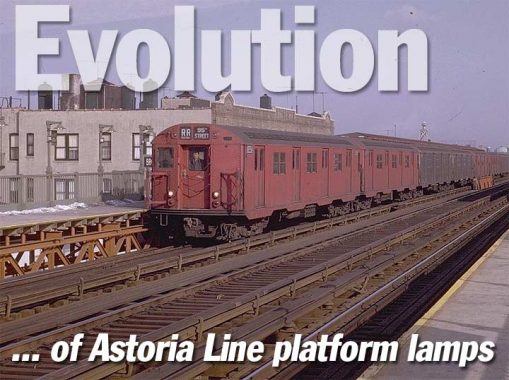While most subway buffs consult David Pirmann’s NYC Subway for looks at subway maps and active and retired subway cars, I occasionally look through it for subway platform lamp stylings over the years. Subway platform lamps are a self-contained genre and contain a number of species that are used on platforms throughout the system. In recent years, the MTA has been bringing back some of these formerly used styles, no doubt consulting older photographs from NYC Subway as well as libraries for blueprints and schematics.
I am veteran rider at the Queensboro Plaza station. When I lived in Bay Ridge, the R train deposited me there so I could cross the platform and get the #7 train to Shea Stadium. When I moved to Queens I wold catch the #7 from its Long Island Rail Road transfer at Woodside and take it to Manhattan or grab the R (or the N, after 1987) at Queensboro. In the early 2000s a free transfer was also effected at Court Square to the E, M and G trains.
I am also a keen observer of lampposts as most FNY readers know. I’ve found it difficult to do a comprehensive survey of elevated train platform lamps. It’s time consuming to get off at each station, photograph the lamps, and get wait for the next train. Still, I intend to undertake this effort for each elevated line sometime soon.
In the meantime I’ve noticed an unfortunate change from a design and esthetics standpoint at Queensboro Plaza I want to discuss today.
From NYC Subway here’s an evocative shot of the west end of the Queensboro Plaza platform in 1968. A RR R-16 car is on the left, while an R-36 World’s Fair Special trainset sits on the #7 tracks. For several decades the IRT and BMT jointly operated the Flushing and Astoria Lines, until the BMT got the Astoria and the IRT got the Flushing in 1949. Thus, this remains the only place in the NYC subways where the IRT and BMT can be accessed across the same platform. There is a track connection, but it’s not used for passenger service.
The Queensboro Plaza station opened on April 21, 1917 and so celebrates its centennial this year. It’s quite likely these are the same relatively thin lamp stanchions, with wider bases, tapering shafts and incandescent bulbs, that had been in use since 1917.
Moving on to 1995 we see that those original stanchions have been wiped out by modernization (which probably occurred in the late 1970s or early 80s). The Arts and Crafts-style standards have been replaced by rectangular shafts supporting bright yellow sodium vapor lamps. The R-36 cars are still in use, but have been painted dark red, giving them their nickname “redbirds.” photo: NYC Subway
I got this shot in the summer of 2015. An N train with R-68 cars is pulling in (R-68s are now rare on the N but can be seen more often on its running buddy, the W). In 2000, the sodium lamps were replaced with a style harking back to the original 1917 lamps, but this time with fluted “hoods” reminiscent of those seen in other BMT stations. Several BMT stations have been using similar lights, such as Sheepshead Bay and 9th Avenue (B, Q). The bulbs were once again yellow sodiums.
While waiting for the N in September 2017 I was disappointed to see that the BMT “hoods” have been lopped off and replaced by one lone Light Emitting Diode fixture per each post. I do not know why LED bulbs could not simply have been screwed into the sockets in the old heads, but the MTA no doubt has its reasons.
Elsewhere on the Astoria Line, this approach had already been taken years ago. Here at Broadway, old standards mounted on the station railing have been maintained, but with sodium lamps mounted at their apices. Since a number of stations on the Astoria Line will be renovated in upcoming years, I wonder of new LED fixtures will be placed here, or they may use the old posts as here.
In 1970 a set of R-30 cars on the RR line enters Broadway. Beginning in 1978, double letter lines were assigned single letters; formerly, double letters on a subway line indicated local service — in most cases. Here we can see those railing-mounted standards holding their original BMT incandescent lights.
One more unnecessary change the MTA made at Queensboro Plaza was replacing the navy and white “QVEENSBORO PLAZA” signs with standard black and white Helvetica. These signs were getting the job done, but the MTA believe nonstandard design to be a plague as far as signage goes, as does the Department of Transportation. Photo: Matt Weber
Check out the ForgottenBook, take a look at the gift shop, and as always, “comment…as you see fit.”
9/28/17
